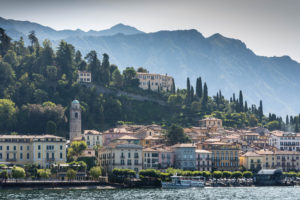“My grandmother kept silkworms beside her bed during the feeding weeks”, recalled Eleanora, the receptionist at Como’s remarkable Silk Museum. “In those days”, she went on, “almost everyone produced silk at home”.

One of the many displays of silk production machines in the Como Silk Museum; this machine was used to heat, soak and unwind the 1,200 metre long silk threads from each cocoon.
The loss of mulberry trees through road and building construction saw the end of silk thread production in northern Italy in 1953. Yet Lombardy, famed for its sparkling lakes nestling between towering peaks, and the villas of the rich and famous, remains the centre of the European silk industry.

The botanical gardens of the Villa Monastero in Varenna, looking north back towards the lakeside village.

A silk dying tub on display in the Como Silk Museum
The Museum, a short walk from Como’s old centre with its beautiful 14th Century cathedral, narrow streets and cafés, tells the fascinating story of silk production. All stages, from raising silkworms, through unwinding cocoons (each is 1,200 metres long), weaving, dying and printing are imaginatively displayed. Introduced in the 15th century by the Dukes of Milan, silk production was initially home-based, but became increasingly mechanised in the 18th and 19th centuries. Although raw silk is now imported, Lombardy’s vibrant silk industry still employs 25,000 workers in weaving, printing and design, drawing on the creative energy of Milan’s fashion houses.

The ferries carry passengers and vehicles, are regular and inexpensive; the various routes link up towns around the lakeshore allowing the visitor many options for exploring charming streets, shops, villas, gardens and gastronomy

Approaching Bellagio on a morning ferry
Regular ferries ply Como’s waters linking the pretty lakeside towns, allowing the visitor to meander from one to another enjoying charming restaurants and discover beautiful villas, providing glimpses of the sumptuous lives of past owners.

The Villa Melzi, Bellagio, former home of Ludovico Melzi d’Eril and aristocrat and benefactor to the region
The shops lining the steep, cobbled streets of Bellagio display the fine silk products by Azalea and Frey of Milan – much better appreciated after visiting Como’s museum.

One of the steep and colourful pedestrianised streets of Bellagio

Como silk from Azalea on display in Bellagio
Cycling offers another rewarding way to experience the breath-taking landscape. Bellagio-based Bike-It offer rental and guided rides, one of which takes a 34 km loop up to the tough little Passo del Ghisallo which features frequently in pro-cycle races. The summit is home to a remarkable cycling museum, well worth a visit, while next door is the cult-like chapel of the Madonna di Ghisallo, patron saint of cyclists.

On the descent from Asso to Onno lying below on the SE arm of Lake Como; Bellagio is situated at the far end of this mountainous promontory.

The extraordinary but solemn chapel of the Madonna di Ghisallo, patron Saint of Cycling located at the summit of the Passo del Ghisallo

The monument to cycling at the summit of the Passo del Ghisallo, providing stunning views and an opportunity to consider the highs (victory) and lows (crashing) of cycling; the museum and chapel are close by.
Only a 45-minute train-ride away, Milan is a must. Most spectacular, is the extraordinary gothic cathedral, built over six centuries and adorned with some 135 steeples and 3500 statues. These are best-appreciated from the rooftop, affording stunning views of the Galleria Vittorio Emanuele II, the palatial 1877 arcade named after Italy’s first king and sporting fashion’s most famous names. Dreamers, or those with deep pockets, can wander through the ‘golden rectangle’ with its stunning world of fashion design and fantasy prices, and once again appreciate the beauty of Italian silk.

Milan’s remarkable ‘International Gothic’ style cathedral, built over six centuries from Lake Maggiore marble; walkways around the roof afford superb views of the spires, sculpture and surroundings.

The 1877 Vittorio Emanuele II shopping arcade, now a temple to high fashion
Information Panel
Education Museum of Silk, Como (entrance fee): http://www.museosetacomo.com/eng_home.php
Bike-It! Based in Bellagio and proving bike rental, itineraries and guided rides: https://www.bikeitbellagio.com/
Museo di Ghisallo (entrance fee – reduction for cyclists making it to the top of the Pass!): https://www.museodelghisallo.it/it/
Milan Cathedral (entrance fee): It is worth planning your visit to the cathedral – more information at https://www.duomomilano.it/en/section/visit-the-duomo/dcffa929-1d39-41db-818c-c19c1d8a0d84/
The Museo di Risorgimento, Milan (free) tells the very intriguing story of the Italian Wars of Independence, and the roles of the Napoleons (Bonaparte and III) in the unification of Italy in 1861: http://www.museodelrisorgimento.mi.it/
Getting there: There are frequent flights to Milan Airport, and the Italian train system provides regular, cheap and easy-to-use services to Como, Lecco and other lakeside towns.
Accommodation: We stayed in an Airbnb in Lecco, £240 for the week; there is a huge range of accommodation of all types in the area.





